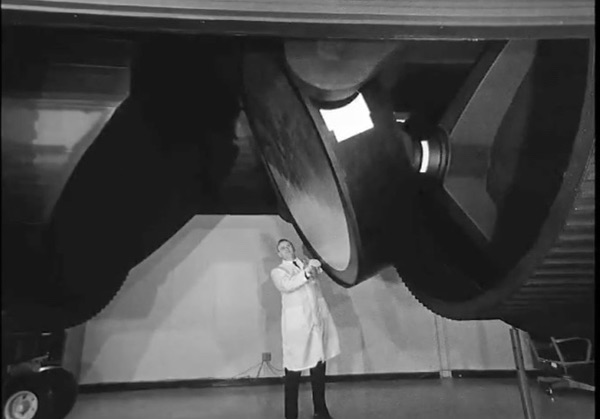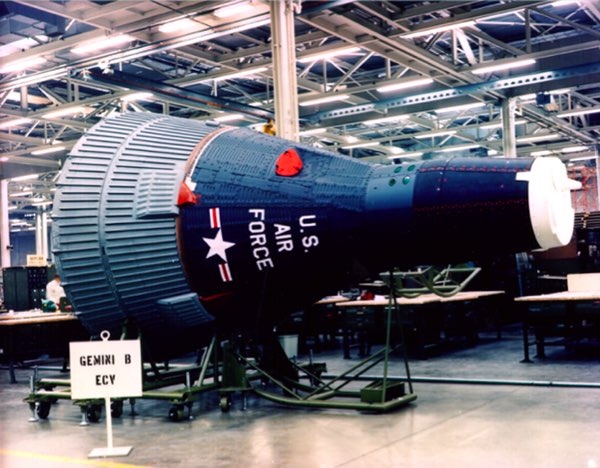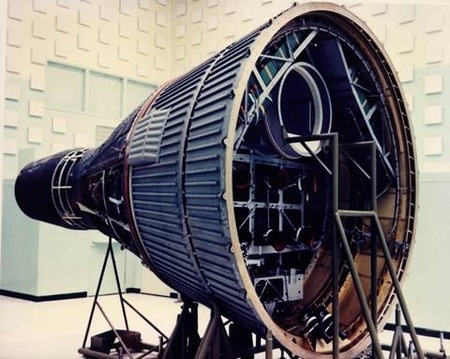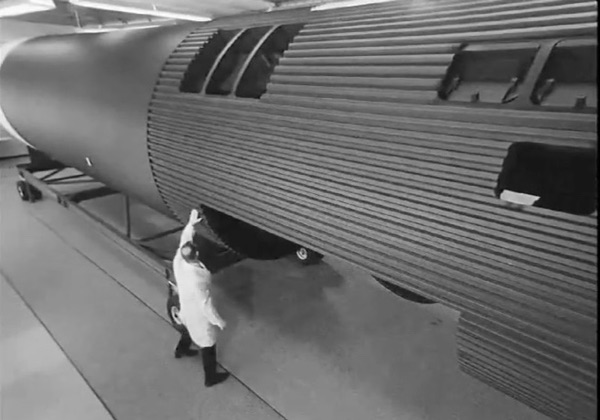Review: Atomic Age Declassified: Spies in Spaceby Dwayne A. Day
|
| The most significant footage is that of a full-scale MOL camera section mockup that was built during the program. That footage, with a technician walking alongside, gives an impression of how big the MOL was. |
In summer 2019 The Smithsonian Channel aired a documentary in its “Atomic Age Declassified” series also called “Spies in Space,” the same name as the NRO book by Courtney V.K. Homer (see: “Review: Spies in Space,” The Space Review, August 26, 2019). Despite the name, and apparently benefitting from NRO assistance, the two projects do not appear to be related—although the fact that they debuted at the same time may have been intentional. “Spies in Space” is superior to “Astrospies” in several ways, including better film footage. The documentary features on camera interviews with retired NASA life sciences expert Dr. John Charles as well as former HEXAGON reconnaissance camera designer Phil Pressel (see “Working in the shadows: Phil Pressel and the Hexagon spy camera,” The Space Review, October 28, 2013; “The Bird is the word,” The Space Review, June 13, 2016; and “The first future MOL,” The Space Review, July 8, 2019), and several commentators such as the NRO historian. It also features interviews with two MOL astronauts, Richard Truly and Bob Crippen. (Crippen told me that he refused to appear in “Astrospies” because he objected to the title.)
 Footage from “Spies in Space” helps convey the size of MOL. |
The documentary benefits significantly from the 2015 MOL declassification. It features film footage that was declassified in recent years, although most, if not all of it, has appeared online in some form. The most significant footage is that of a full-scale MOL camera section mockup that was built during the program and reveals the DORIAN camera’s large rotating image reflecting mirror (although not the internal image focusing optics.) That footage, with a technician walking alongside, gives an impression of how big the MOL was.
 . |
Also fascinating is footage of numerous engineering and operations tests, such as astronauts practicing crawling through the tiny hatch and long tunnel in a mockup of the Gemini spacecraft and MOL hardware that was carried inside an Air Force transport aircraft performing parabolic maneuvers to simulate zero gravity. The astronauts had to get out of their seats, turn around, open and stow the hatch, and pull themselves through the tunnel during the approximately half-minute of zero gravity; it wasn’t easy, but they proved it was possible. Other interesting footage shows astronauts and engineers working with various mockups. Some of the MOL laboratory mockups were only made of cardboard, whereas some underwater tests were done with mockups made of wire frames. The documentary even includes color film footage of the recovery of the Gemini spacecraft that tested the hatch cut into the reentry heat shield. When technicians opened the Gemini’s main hatches onboard the recovery ship USS La Salle, they revealed instrumentation located where the astronauts would normally sit, and confirmed that the hatch had not allowed gases or the heat of reentry to penetrate the spacecraft.
 . |
Although the MOL program started in early 1964 and the first astronaut selection was announced in 1965, the documentary frequently flashes back to important reconnaissance developments a few years earlier, such as the first successful CORONA mission in August 1960 and the summer 1963 debut of the higher-resolution GAMBIT-1 reconnaissance satellite. It also refers to the October 1962 Cuban Missile Crisis, where satellite imagery played no role, but a U-2 was shot down, demonstrating the risks to reconnaissance aircraft. The selected events are the correct ones, although viewers who do not pay close attention or who are unfamiliar with the Cold War may get a bit confused by the timeline jumps. One of MOL’s vulnerabilities was that robotic systems that started performing reconnaissance missions early in the decade were continuing to improve with every mission, whereas MOL was still years away from flight—and over-budget.
| Documentaries often have only 42 minutes to cover a subject, and this can constrain their ability to capture complexity and nuance. |
“Spies in Space” is an excellent documentary, with good information and new and interesting footage and no major errors except one: once again using the artwork of the civilian version of MOL rather than an accurate illustration of the reconnaissance spacecraft. Unfortunately, the producers missed the opportunity to provide good quality computer animation showing how the astronauts would have worked inside the MOL and how the entire system—Gemini, access tunnel, pressurized module, and DORIAN camera system—was constructed. The available declassified MOL imagery is poor quality, meaning that it is up to current-day artists to properly illustrate the hardware, and “Spies in Space” did not do this. The documentary does make great use of some contemporary contractor artwork supplied by John Charles that was converted into short animations.
Like the book of the same name, the “Spies in Space” documentary leaves out some important information. Although Phil Pressel was interviewed and discussed the HEXAGON system in detail, his appearance is very short, and the producers did not explain the complex drama of MOL’s final months, when HEXAGON was canceled, reinstated, and then MOL was canceled instead. There is also no mention of the sprawling launch site built for MOL at Vandenberg Air Force Base in California known as SLC-6 (“Slick-6”), or the court battle over the Air Force’s acquisition of private land. Although it is a minor point, the documentary also did not discuss the Titan IIIM rocket, which was planned to be more powerful than the Titan IIIC that is shown several times. Documentaries often have only 42 minutes to cover a subject, and this can constrain their ability to capture complexity and nuance. By only interviewing Crippen and Truly, for instance, the producers got a limited perspective of why MOL ran behind schedule and over budget. Not all sources agree with Truly’s statement that insufficient funding early in the MOL program led to increased costs as well as schedule delays later on. Another astronaut, Al Crews, concluded that some contractors were wasting money on the program. He also believed that the increasing capabilities of robotic spacecraft meant that MOL’s days were limited, something that the documentary does touch on. But all things considered, “Spies in Space” is an excellent overview of the program. Perhaps the producers will someday turn their attention to the robotic CORONA, GAMBIT and HEXAGON programs, or even the Soviet Almaz space stations, and give them the attention that they also deserve.
Note: we are temporarily moderating all comments subcommitted to deal with a surge in spam.
